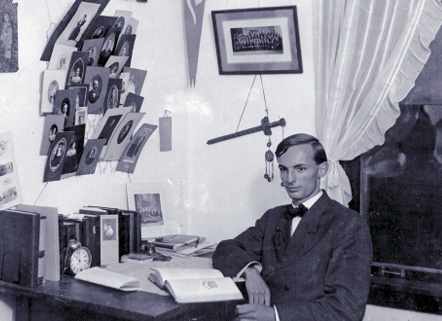
PORTRAIT OF A YOUNG DORM: F. Kurt Zutavern in his Fiske Hall dorm room.
Fairmount College staged its first major public event, other than commencements, when the cornerstone for a boys' dormitory was laid on Oct. 28, 1904.
The program featured a procession, a ceremony by the Grand Lodge of the Masons of Kansas, multiple speeches and the singing of college songs — "Fair Fairmount" and "As the Backs Go Tearing By."
President Morrison presided and indicated where future buildings would be, based on his new campus plan.
Football captain Graham Foster '06 spoke for the students. Charles Davidson, mayor of Wichita from 1909-11, represented the community. And Charles Cohn, owner of the Boston Store, represented the Board of Trustees. The Wichita Eagle captured the spirit of the occasion when it reported that "Fairmount was in her glory yesterday."
The long-awaited dorm was made possible by a gift from Mrs. Charlotte M. Morse Fiske, and it was named for her. The Fiskes of Wrentham, Sturbridge and Fiskdale, Mass., were prominent in manufacturing, professional and Congregational activities, and family members had supported the Congregational college of Fairmount since its early years.
Chicago architect Normand Patton was selected to design the building. He was nationally known for his college buildings, Carnegie libraries and Congregational churches, and he had designed Fairmount Hall two decades earlier. Patton departed from the Romanesque style of Fairmount and presented Fiske as a restrained interpretation of the Beaux Arts style. He lived in Oak Park where his neighbor Frank Lloyd Wright (who would design a campus building 50 years later) was beginning his practice.
For the next two decades, Fiske and its women's counterpart, Holyoke Cottage and Hall, were focal points of campus life. As the 1914 Parnassus noted, "Any boy who goes through Fairmount College without spending a year at the Dorm has lost a valuable part of his education." Residents were involved in music, sports, debate, journalism and some were even labeled "bookworms."
The first campus booster group, the Yellow Dogs, operated out of Fiske and supported Wheatshocker teams in every kind of competition. Kurt Zutavern fs '10 operated a printing and photo lab in the basement and left many pictures of dorm life, including a shot of his own room, above.
During World War I, Army cadets were housed in the dorm, which also served as an infirmary for flu victims in 1918. That same year, Fairmount started an ROTC program headquartered in Fiske's basement, and it continued there until a WWII barracks was acquired as an armory in 1947. Donald Thompson '26, captain of Company D in 1925-26, recalls picking up his rifle in Fiske and marching out to drill in Henrion Gymnasium or on the football field to the east.
In 1926, the new municipal university discontinued housing for men, and Fiske served as the administration building for presidents Finlayson and Foght until Administration (later Jardine) Hall was completed in 1930. For the next quarter century, with the exception of WWII, it housed fine arts programs — along with ROTC in the basement. Fiske became known unofficially as the Music Building and, as in its dormitory day, became alive with students presided over by its chain-smoking dean, Walter Duerksen.
After Duerksen Fine Arts Center opened in 1956, Fiske provided office space for a variety of programs, including the history and philosophy departments, which now hold the record as the longest tenants of the building. In 1952, the music sorority Mu Phi Epsilon held a fund raiser called The Risque Fisque Fair. The final number was a new version of the Alma Mater, and the words, written by Helene Sykes Barnes '52 and provided by Julia Hoppes '52/60, serve as a finale here:
Our Alma Mater, Old Fiske Hall
Leans proudly 'gainst the hill.
Now you may think that it will fall
But you're wrong, it never will.
The termites, mice and ivy
Hold the walls up firm.
It will still be standing here
When we have served our term.





